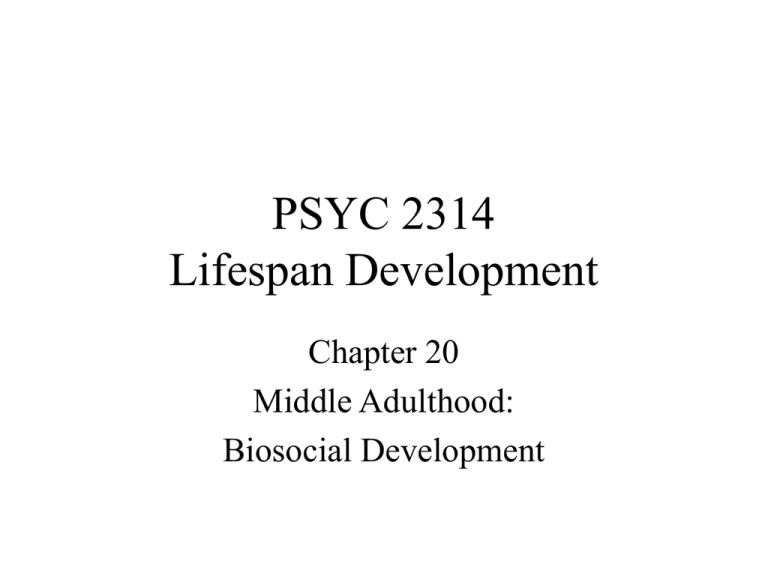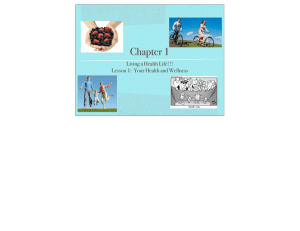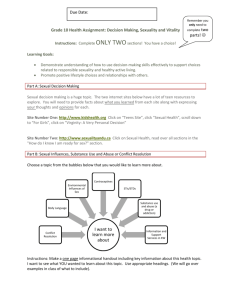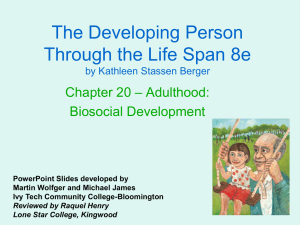PSYC 2314 Lifespan Development
advertisement

PSYC 2314 Lifespan Development Chapter 20 Middle Adulthood: Biosocial Development Physical Changes in Middle Adulthood • • • • Graying and thinning of the hair Drying and wrinkling of the skin Change in body shape Loss in height Sense Organs • Hearing – – – – Environmentally caused Men are more likely to developed hearing loss Genetic Age Sense Organs • Vision – Farsightedness and astigmatism – Depth perception, eye-muscle resilience, color sensitivity and adaptation to darkness – Glaucoma Vital Body Systems • Immune system is actually stronger. However, recovery takes longer. • Autoimmune disease—when the immune system mistakes the person’s own body cells for foreign invaders and attacks them (rheumatoid arthritis or lupus). Health Habits • Smoking – A risk factor for many diseases. – Nonsmokers have a 30% higher risk of lung cancer if they are married to smokers than if they are married to nonsmokers. – All smoking diseases are dose- and durationsensitive. Health Habits • Alcohol – – – – – – Moderate use may lower the risk of heart disease Heavy use is the main cause of cirrhosis of the liver Puts stress on the heart and stomach Destroys brain cell Hastens calcium loss associated with osteoporosis A risk factor in many forms of cancer Health Habits • Nutrition – Strongly related to the onset and progress of heart disease and cancer. – A high-fat, low-fiber diet promotes the development of heart disease and several types of cancer. Health Habits • Weight – Overweight is present in 2 out of every 3 middle-aged residents of the US. – Obesity is a risk factor for heart disease, diabetes, and stroke. It is also a contributing factor for arthritis. Health Habits • Vigorous exercise for at least 30 minutes daily: – – – – Increases heart and lung capacity and metabolism Lowers blood pressure Reduces the ratio of body fat to body weight Enhances cognitive functioning through improved blood circulation – Improves self-image and general sense of well-being Variations in Health • Four distinct measures of health – – – – Mortality Morbidity Disability Vitality • Quality-adjusted life years (QUALYs): calculates how many years of full vitality are lost as a result of a particular disease or disability. Ethnicity and Health • Mortality – African Americans die at twice the rate of European Americans, who themselves die at twice the rate of Asian Americans. – Native Americans have about 20% higher death rate and Hispanic Americans a 20% lower rate than the overall average • Morbidity and disability follow the same ethnic patterns. Beyond Black and White • Group differences in health are often misattributed to genes and ancestry: – Current education – SES – Pressures and opportunities provided by the larger society Gender Differences • Mortality – Middle-aged men are twice as likely to die of any cause and three times as likely to die of heart disease. • Men are more likely to smoke, drink, be overweight, repress emotions, and ignore their medical symptoms. • Morbidity and disability – Women have higher rates than men. Sexual Reproductive System • Sexual responses gradually become slower and less distinct • Reproduction less likely • Attitudes are more important than biology in assessing the impact of these changes. The Climacteric • Climacteric: various biological and psychological changes that accompany menopause: – Variations in the timing of a woman’s menstrual cycle – Hot flashes and cold sweats – Drier skin – Loss of breast tissue, bone calcium HRT • Hormone Replacement Therapy – Reduce the risk of coronary heart disease, Alzheimer’s disease, tooth loss, and hip fractures. – Long-term consequences are not yet known, however, may increase the risk of some forms of cancer, particularly breast cancer. Psychological Impact of Menopause • Historical changes have meant that the end of childbearing is now determined less by age than by personal factors, such as the number of children a couple already has or the couple’s financial status. The end of childbearing thus represents a conscious decision and makes menopause—the time when sexual activity is no longer accompanied by fear of pregnancy—a liberating and welcomed event. Sexual Expression • Sexual activities usually declines in terms of frequency of intercourse and orgasm. • Sexual stimulation, esp. in men, takes longer and needs to be more direct • A reduction in the intensity of orgasmic reactions and less vigorous contractions and ejaculations.




